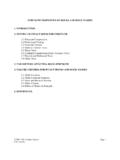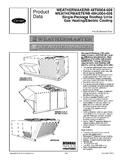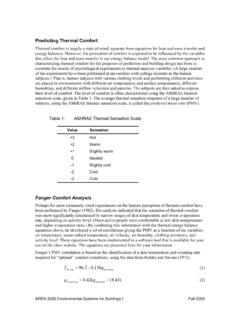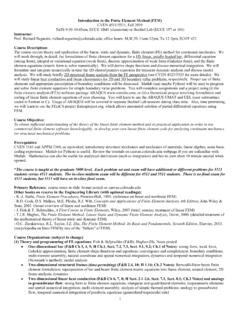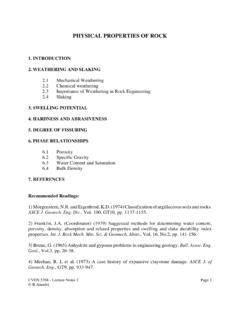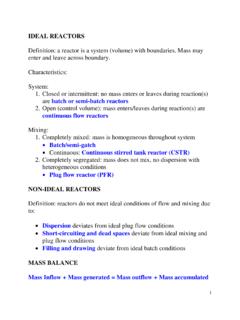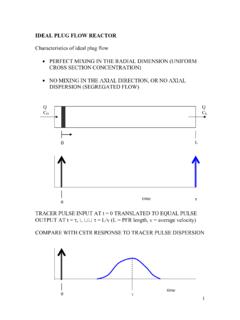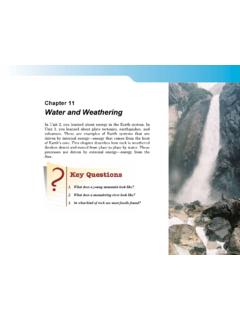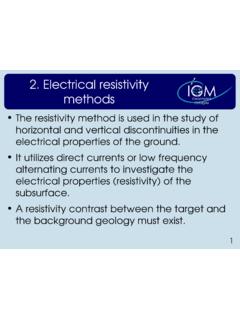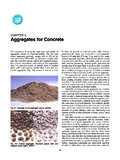Transcription of DEFORMABILITY PROPERTIES OF ROCKS AND ROCK MASSES …
1 DEFORMABILITY PROPERTIES OF ROCKS AND ROCK MASSES . 1. introduction . 2. DEFORMABILITY OF intact ROCK. Rock under Uniaxial Compression Dynamic Elastic Constants Hooke's Law Rock Anisotropy Laboratory Testing 3. ROCK MASS DEFORMABILITY . Characterizing Rock Mass DEFORMABILITY Measuring Rock Mass DEFORMABILITY 4. REFERENCES. Recommended Readings: 1) Chapter 6 in introduction to Rock Mechanics, by Goodman, Wiley, 1989. 2) Bieniawski, and Bernede, (coordinators) (1979) Suggested methods for determining the uniaxial compressive strength and DEFORMABILITY of rock materials, Int. J. Rock Mech. Min. Sci. & Geomech. Abstr., Vol. 16, , pp. 135-140. 3) Amadei, B. (1996) Importance of anisotropy when estimating and measuring in situ stresses in rock, Int. J. Rock Mech. Min. Sci. & Geomech. Abstr., Vol. 33, , pp. 293-325. 4) Luehring, (1988) Methods for determining in situ deformation of rock MASSES , Bureau of Reclamation Report REC-ERC-87-14. CVEN 5768 - Lecture Notes 5 Page 1.
2 B. Amadei 1. introduction . Engineers need to know how ROCKS and rock MASSES deform when subject to the various loads associated with engineering structures. Deformation can take the form of settlements of surface structures, surface subsidence or closing of the walls of underground openings. The overall stability of concrete dams depends, in part, on the relative DEFORMABILITY of the foundation rock with respect to the concrete. Rock DEFORMABILITY can be instant or time-deferred. Rock mass DEFORMABILITY depends on the DEFORMABILITY of both intact rock and the discontinuities. In this chapter, we will first talk about the DEFORMABILITY of intact rock; isotropic and anisotropic formulations will be presented. Then, we will investigate the contribution of discontinuities in the DEFORMABILITY of rock MASSES . The problem of scale effect will also be addressed. 2. DEFORMABILITY OF intact ROCK. Rock under Uniaxial Compression Consider a rock specimen subjected to uniaxial compression.
3 Let ,a and ,l be the axial and lateral (diametral) strains measured during the test and F be the applied axial stress. Figure 1. shows a typical set of stress-strain response curves. The plot can be divided into four regions: C region OA corresponds to the closing of microcracks and a general adjustment of the system consisting of the rock and testing machine. This region is usually concave upwards, C region AB is more or less linear and corresponds to the elastic response of the rock, C region BC is associated with strain hardening and is concave downwards, C region CD corresponds to strain softening. At any stress level in region AB, the rock will follow a path essentially parallel to AB upon unloading and reloading. In that domain, the rock sample can be modeled as a spring. If the rock is isotropic, two elastic constants can be introduced to describe its DEFORMABILITY : the Young's modulus, E, and the Poisson' s ratio, <, with (1). and (2). where dF, d,l and d,a are increments of stress, lateral strain and vertical strain, respectively.
4 CVEN 5768 - Lecture Notes 5 Page 2. B. Amadei Figure 2 shows three methods suggested by the ISRM for determining the Young's modulus from axial stress-strain curves (Bieniawski and Bernede, 1979) and Figure 3 shows an example of calculation of those PROPERTIES . Various authors have compiled the values of E and < for different rock types (Balmer, 1953;. Johnson and DeGraff, 1988; Hatheway and Kiersch, 1989; ). Examples are given in the following tables. Granite Basalt Gneiss Schist Quart- Marble Lime- Sand- Shale zite stone stone Av. E Max. E Min. E Range No. of samples 24 16 17 18 10 16 29 18 9. Table 1. Typical values of Young's moduli (in GPa) for nine common rock types (after Johnson and Degraff, 1988). Granite Basalt Gneiss Schist Quart- Marble Lime- Sand- Shale zite stone stone Av. < Max. < Min. < Range No. of samples 24 16 17 18 10 16 29 18 9. Table 2. Typical values of Poisson's ratios for nine common rock types (after Johnson and Degraff, 1988). Linearity in the material behavior in uniaxial compression will also be reflected in its response to pure shear and hydrostatic compression.
5 For instance, if a increment in shear stress dJ is applied, an increment in (engineering) shear strain, d(, will result such that (3). where G is called the shear modulus. On the other hand, for an increment of hydrostatic load dp, an increment in volumetric strain, d,v, will result such that CVEN 5768 - Lecture Notes 5 Page 3. B. Amadei (4). where K is called the bulk modulus. Note that G and K are related to E and < as follows (5). Dynamic Elastic Constants The Young's modulus, Poisson's ratio and shear modulus can be determined by dynamic methods. Dynamic elastic PROPERTIES are obtained by rapid application of stress to a rock specimen. One method of achieving this is to subject the specimen to ultrasonic compression and shear wave pulse using a so-called sonic velocity equipment (see section 5 in Lecture Notes 2). The method is called the seismic pulse method. Using the theory of elastic wave propagation, the dynamic Young's modulus, Ed, Poisson's ratio <d, and shear modulus Gd are calculated from the measured shear and longitudinal wave velocities Vs and Vp (about Vs) as follows (6).)
6 Where ( is the unit weight of the rock and g is the acceleration due to gravity. An example of calculation of dynamic elastic PROPERTIES taken from Johnson and Degraff (1988) is given below for a specimen of Pikes Peak granite: Core length, L = m. Unit weight, ( = kN/m3. Acceleration due to gravity, g = P-wave travel time through core, tp = x 10-5 sec. S-wave travel time through core, ts = x 10-5 sec. P-wave velocity, Vp = L/tp = 4, m/sec S-wave velocity, Vs = L/ts = 2, m/sec Dynamic Poisson's ratio, <d = Dynamic Young's modulus, Ed = GPa In general, the dynamic Young's and shear moduli are larger than their static values (there are however instances where the opposite is true). Eissa and Kazi (1988) studied the relation existing between the static modulus E (secant or tangent) and the dynamic modulus, Ed. Analysis of 342 observations gave the following empirical equation CVEN 5768 - Lecture Notes 5 Page 4. B. Amadei (7). with a coefficient of correlation of Another empirical equation, (8).))
7 Gave a coefficient of correlation of In both equations (7) and (8), the moduli are in GPa and in equation (8), D is the rock density in g/cm3. Kazi et al. (1983) proposed an empirical equation relating the uniaxial compressive strength of intact ROCKS to their dynamic modulus. A statistical analysis of more than 200 tests reported in the literature on seven different rock types yielded the following empirical equation (9). Hooke's Law Isotropic Formulation In three dimensions, the DEFORMABILITY of a linearly elastic continuum is described by Hooke's law. Assuming isotropy, the stresses and strains in an arbitrary x,y,z coordinate system are related as follows (10). Note that two and only two elastic constants, namely the Young's modulus, E, and the Poisson's ratio, <, are needed to describe the DEFORMABILITY of a medium in its linear elastic range if the medium is assumed to be isotropic. For continua that are anisotropic ( with directional DEFORMABILITY PROPERTIES ), more than two elastic constants are required, as discussed below.
8 CVEN 5768 - Lecture Notes 5 Page 5. B. Amadei Anisotropic Formulation The DEFORMABILITY of anisotropic linearly elastic media is, in general, described by more than two elastic constants. In an arbitrary x,y,z coordinate system, the components of stress and strain are related as follows (11). or in a more compact form (12). which is known as the Generalized Hooke's law. Matrix [A] is a (6x6) compliance matrix which is symmetric with aij=aji (i,j=1-6).The inverse form of equation (12) can be expressed as follows (13). where [C] is the matrix of elastic constants. Since matrices [A] and [C] are symmetric, they have at most 21 independent components. That number can be further reduced to 13, 9, 5 and finally to 2 (in the isotropic case), if the medium has any symmetry in the x,y,z coordinate system. Coordinate Transformation of the Generalized Hooke's Law Consider two rectangular coordinate systems x,y,z and xU,yU,zU. The orientation of the xU-, yU-, zU-axes is defined in terms of the direction cosines of unit vectors eU1, eU2 and eU3 in the x,y,z coordinate system (see equation (10), Lecture Notes 3).
9 The constitutive equation of the medium in the x,y,z coordinate system is given by equation (12). In the xU,yU,zU coordinate system, it is expressed as (14). CVEN 5768 - Lecture Notes 5 Page 6. B. Amadei The compliance matrices [A] and [A'] are related. Combining equations (12) and (14), and equations (13), (52) and (53) in Lecture Notes 3, it can be shown that (15). and (16). Note that in general, matrices [A] and [AU] are different unless the material is isotropic, in which case the compliance components are independent of the coordinate system (since the material is isotropic). Rock Anisotropy Types of Anisotropic ROCKS Many ROCKS exposed near the Earth's surface show well defined fabric elements in the form of bedding, stratification, layering, foliation, fissuring or jointing. In general, these ROCKS have PROPERTIES (physical, dynamic, thermal, mechanical, hydraulic) that vary with direction and are said to be inherently anisotropic. Anisotropy can be found at different scales in a rock mass ranging from intact specimens to the entire rock mass.
10 Anisotropy is a characteristic of intact foliated metamorphic ROCKS (slates, gneisses, phyllites, schists). In these ROCKS , the fabric can be expressed in different ways. Closely-spaced fractures called cleavages are found, for instance, in slates and phyllites. These ROCKS tend to split into planes due to parallel orientation of microscopic grains of mica, chlorite or other platy minerals. In schists, the fabric is created by the parallel to sub-parallel arrangement of large platy minerals such as mica, chlorite and talc. Foliation can also be expressed by alternating layers of different mineral composition such as in gneisses. Non-foliated metamorphic ROCKS such as marble also show some anisotropy due to preferred orientation of calcite grains. Anisotropy is also the characteristic of intact laminated, stratified or bedded sedimentary ROCKS such as shales, sandstones, siltstones, limestones, coal, Here, the anisotropy results from complex physical and chemical processes associated with transportation, deposition, compaction, cementation, is noteworthy that ROCKS which have undergone several formation processes may present more than one directions of planar anisotropy such as foliation and bedding planes in slates.
